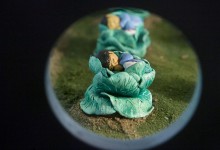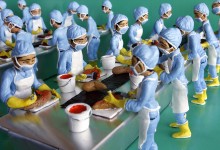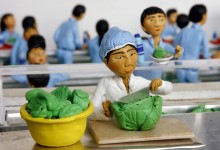Every year thousands upon thousands of Chinese young people migrate to cities to work in manufacturing plants that feed the world’s seemingly insatiable appetite for consumer products. An amazing variety of goods, from alarm clocks to zebra print pyjamas, from toy phones to iPhones, are produced in huge factory complexes with worker dormitories.
With “All you can eat”, Karine Giboulo has constructed a three dimensional food processing plant making ribs and wings from pigs that fly. The viewer looks through windows and into a series of rooms with different scenes. Workers can be seen on the production line but also having lunch in the cafeteria or at rest in their dormitories. The artist’s aim is to put a human face on this invisible army of workers that we know so little about and who produce so many of our goods. She seeks to pay hommage to the Chinese youth who live and work in factory complexes so that we can have “all we can eat” at the cheapest prices and for maximum profit.
“All you can eat” refers to our seemingly bottomless appetite for consumer goods of all sorts. This is represented in the installation by the production and consumption of food. The effect of overconsumption can be seen on a pair of obese groundhogs gorging themselves on “all you can eat” ribs and wings in a sports bar. The finely sculpted scenes are colourful and contain humour but are also a serious commentary on our rampant consumerism, personnified in the installation by the gluttonous groundhogs. The world’s hunger for consumer goods is fed by the apparently limitless capacity of ecomonies like China, with their millions of “cheap” labourers.
Karine Giboulo visited the city of Shenzhen in southern China’s Guangdong province in December and was able to tour a cell phone factory as well as the dormitories and cafeteria. “I was amazed by the sheer number of these factory complexes, mile after mile. Sometimes all the buildings of a complex would be the same color, green, yellow, pink etc. and I could imagine them all filled with workers dressed in the same colors. To me the factories resemble work camps and even though the young people are not prisoners their working conditions can be difficult and dangerous and their wages are very low. Living conditions in the dorms are also very basic. Despite this I saw the young workers laughing, playing soccer and riding bikes. I saw young couples in love walking hand in hand. The factories are not only their workplace, they are where they live all aspects of daily life. “















